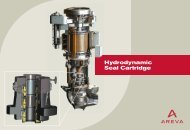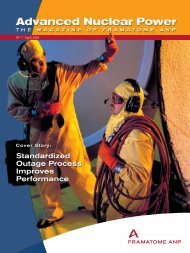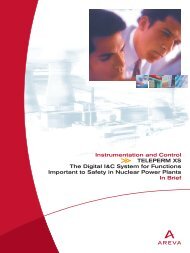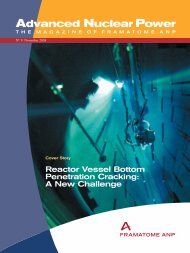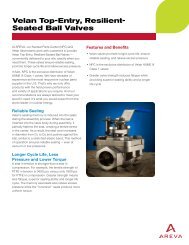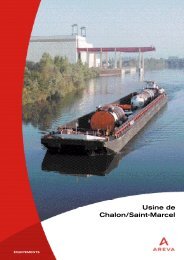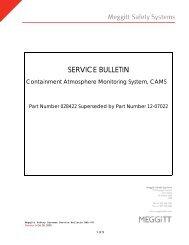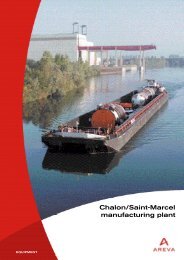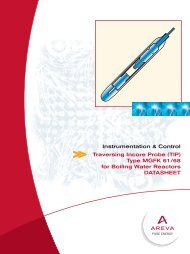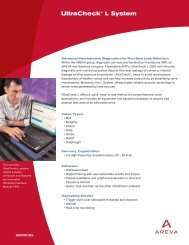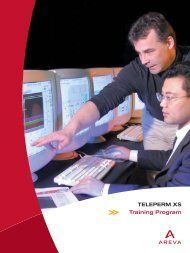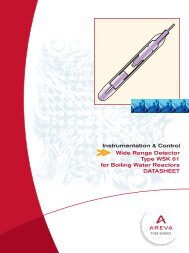EPR – Areva brochure
EPR – Areva brochure
EPR – Areva brochure
Create successful ePaper yourself
Turn your PDF publications into a flip-book with our unique Google optimized e-Paper software.
■ <strong>EPR</strong> NUCLEAR ISLANDINSTRUMENTATION & CONTROL SYSTEMA nuclear power plant, like any other industrial facility, needs technical means to monitor and control itsprocesses and equipment. These means, as a whole, constitute the plant Instrumentation & Control (I & C)processes, which actually comprises several systems and their electrical and electronic equipment.Computer-generated image of the <strong>EPR</strong> control room.ROLE OF THE I & C SYSTEMSBasically, the I & C system is composed of sensors to transformphysical data into electrical signals, programmable controllersto process these signals and control actuators, monitoring andcontrol means at the disposal of the operators.The overall design of the I & C system and associated equipmenthas to comply with requirements imposed by the process, nuclearsafety and operating conditions.To design the <strong>EPR</strong> and its I & C system, specific attention has beengiven to ensure a high level of operational flexibility in order to fit withelectricity companies’ needs. As a result, the <strong>EPR</strong> is particularly welladapted to load follow and remote control operation modes.† A plant I & C system, completelycomputerized, supported bythe most modern digital technologies,for high-level operational flexibility<strong>EPR</strong> I & C OVERALL ARCHITECTUREInside the overall I & C architecture, each system is characterizeddepending on its functions (measurement, actuation, automation,man-machine interface) and its role in safety or operation of the plant.Safety classificationI&C functions and equipment are categorized into classes inaccordance with their importance to safety. Depending on theirsafety class, I & C functions must be implemented using equipmenthaving the appropriate quality level.Redundancy, division, diversity and reliabilityI&C systems and equipment of the <strong>EPR</strong> comply with the principlesof redundancy, division and diversity enforced for designing <strong>EPR</strong>safety-related systems. As an illustration, the Safety Injection Systemand the Emergency Feedwater System, which consist of fourredundant and independent trains, have four redundant andindependent I & C channels.Each safety-related I & C system is designed to satisfactorily fulfil itsfunctions even if one of its channels is not available due to a failureand if, at the same time, another of its channels is not available forpreventive maintenance reasons or due to an internal hazard (e.g.fire).I&C systems and equipment participating in safety functions arespecified with a level of availability in compliance with the safetyprobabilistic targets adopted to design the <strong>EPR</strong>.I&C architectureThe I & C systems act in accordance with the “defense in depth”concept.Three lines of defense are implemented:• the control system maintains the plant parameters within theirnormal operating ranges,• in case a parameter leaves its normal range, the limitation systemgenerates appropriate actions to prevent protective actions fromhaving to be initiated,• if a parameter exceeds a protection threshold, the reactor protectionsystem generates the appropriate safety actions (reactor trip andsafeguard system actuation).Normally, to operate and monitor the plant, the operators useworkstations and a plant overview panel in the Main Control Room.In case of unavailability of the Main Control Room, the plant ismonitored and controlled from the Remote Shutdown Station.A several level structureConsideration of the different roles played by the different I & Csystems leads to a several level structure for I & C architecture:• level 0: process interface,• level 1: system automation,• level 2: process supervision and control.(A level 3 deals with site management functions).Different general requirements are assigned to each level.The “process interface” (level 0) comprises the sensors, and theswitchgears.The “system automation” level (level 1) encompasses I & C systemsto perform:•reactor protection,• reactor control, surveillance and limitation functions,•safety automation,• process automation.The “process supervision and control” (level 2) consists of:• the workstations and panels located in the Main Control Room,the Remote Shutdown Station and the Technical Support Centre,which are also called the Man-Machine Interface (MMI),• the I & C systems which act as link between the MMI and the“system automation” level.† A quadruple redundant safety-related I & Cfor a further increased level of safety.Description of the I & C architectureFunctionalsafety classEquipmentquality levelF1A Functions required in case of accident E1Ato bring the reactor to controlled state.F1B Functions required after an accident to bring E1Bthe reactor to safe state.Functions intended to avoid the riskof radioactive releases.F2 Other functions contributing to plant safety E2(adherence to limit operating conditions,surveillance of safety system availability,protection against the effects of internallygeneratedhazards, detection/monitoringof radioactive releases, functions usedin post-accident operation…).NC Non-classified functions. NCI&C technologyConcerning I & C technology, Framatome ANP uses a consistentI&C system based on its TELEPERM-XS technology for safetyapplications and on a diversified technology for standard applications.Remoteshutdown stationRCSLReactor tripbreakers,control rodactuationF2 CRDMsensorsSICSPSF1AsensorsPACF1A/F1BactuatorsSASF1BsensorsF1BactuatorsPICSF2/NCsensorsPASF2/NCactuatorsMaintenancetechnical roomTechnicalsupport centerSafety InformationSICS& Control SystemProcess InformationPICS& Control SystemReactor Control,RCSL Surveillance andLimitation SystemPS Protection SystemSafety AutomationSASSystemProcess AutomationPASSystemPriority and ActuatorPACControl ModuleControl Rod DriveCRDMMechanismTXS*DiversifiedTechnology*TELEPERM-XS Framatome ANP technology.40 II 41



